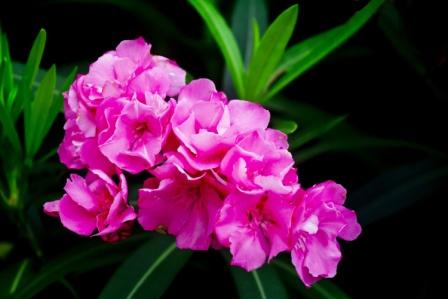Nerium indicum – Karavira – Benefits, Usage, Side Effects – Ayurveda details
Karaveera is a toxic herb used in Ayurvedic therapeutics. Its external application is indicated in toxic bites.
Botanical Name- Nerium Indicum (N. Odorum Soland).
Family- APOCYNACEAE (Kutaja Kula)
Table of Contents
Vernacular Names
Hindi Name- Kaner, Kanail
Telugu Name- Erra Ganneru, Jannerat
English Name- Indian Oleander
Bengali Name- Karavi
Marathi Name- Kanher
Gujarati Name- Kaner, Karena
Tamil Name- Arali
Arabian Name – Sammul hibar
Farsi name – Kharjahara
Sanskrit synonyms
Asvamaraka, Hayamara, Hayamaraka – kills horse
Chandataka, Pratihara
Abjabijabhruta- Seeds resembles to lotus seed

Classical categorization
Charaka-
Kusthaghna – group of herbs used in the treatment of skin diseases
Tiktaskandha – bitter tasting group of herbs
Susruta- Lakshadi, Sirovirechana
Vagbhata- Lakshadi
Different varieties
Samhithas and Nighantus mainly described two varieties. Viz. white and red varieties, which are identified as N.indicum botanically. The difference between the two lies in the colour of the flower.
In Raja Nighantu, four kinds of Karavira are described viz. Shweta (white), Rakta (red), Peeta (yellow) and Krishna (black) varieties.
The yellow variety is Thevetia peruviana (pers. K. Schum).
Distribution
Cultivated as an ornamental shrub in gardens throughout India. In Southern India, it is found on the road sides and grown over the fences. Its flowers are used in God worship.
Morphology
Evergreen shrub
Leaves – Linear, lanceolate, dark green above with stout midrib
Flowers – White or pink coloured
Fruits – Follicles
Major chemical constituents
N. Indicum– Karabin, Neriodorein, Neriodorin, B-Sitosterol, Neriodin, Neriodorin, Nerium D, Nerium E (Anhydro Oleandrin), B- D Digitaloside, Nerioside, obandrin, Digitoxigenin, oleandroside, rutin, plumericin etc.
T. Peruviana– Epiperuviol Acetate, Cerberoside (thevetin B), Thevetin A, Thevefolin, Neriifolin, Cerberin, Perveside, Peruvosidic Acid(Perusititiin), Ruvoside, Theveneriin, Theveside, Theviridoside, Thevetin, Viridoside etc.
(Reference: Illustrated Dravyaguna Vijnana, Vol. II, by Dr JLN Shastry)
Medicinal properties
Medicinal Properties of Nerium indicum
Rasa (taste) – Katu (pungent), Tikta (bitter)
Guna (qualities) – Laghu (lightness), Rooksha (dryness)
Veerya – Ushna – hot potency
Vipaka- Katu – undergoes pungent taste conversion after digestion.
Effect on Tridosha – Balances Kapha and Vata.
Part used, dosage
Part used- Root/ root bark
Dosage- Powder 30-125 mg per day is its maximum dose.

Therapeutic uses
The below qualities are seen on external application. On internal administration, it acts as poison.
Jwarapaha – useful in fever
Chakshushya – good for eyes – leaf juice extract is used as eye drops to relieve eye inflammation.
Kushtahrut – useful in skin diseases. Its root paste is applied over the wounds of syphilis.
Kandughna – relieves itching
Akshikampa – relieves excessive movement of eyes
Vranapaha – useful in quick wound healing
Ayurvedic medicines
Ayurvedic medicines with Nerium indicum / Nerium odorum as ingredient –
Manikya Ras – Used in allergic dermatitis, fever
Chitrakadi Taila – useful in fistula treatment, for external application.
Brihat Marichadi Taila – useful in the treatment of spondylosis, sciatica etc.
Side effects
Nerium indicum side effects –
It is a cardiac toxic herb. Hence it should not be used without doctor’s advice.
It is not safe for children, pregnant and lactating mothers, even for external application.
Keep this herb out of sight and reach of children.
Accidental oral intake may lead to severe poisonous symptoms.
Toxic symptoms
Vomiting
Abdominal pain
Frothy salivation
Restlessness
Slow and weak pulse
Lock jaw
Exhaustion and drowsiness
Coma, finally death
Fatal dose
15 gm of root
Fatal period
24 hours
Treatment
Stomach wash
Interaction with medicines, supplements
Can this be used while taking Homeopathic medicine?
Yes. This product does not react with homeopathic medicine.
Can this medicine be continued while taking supplements like multivitamin tablets, Omega 3 fatty acids etc?
Yes. Generally, this product goes well with most dietary supplements. However, if you are taking more than one product per day, please consult your doctor for an opinion.
With western
medicines
Seek your
doctor’s advice if you are taking this product along with other western
(allopathic / modern) medicines. Some Ayurvedic herbs can interact with modern
medicine.
If both Ayurvedic and allopathic medicines are advised together, then it is
best to take Allopathic medicine first, wait for 30 minutes and then take the
Ayurvedic medicine.
Miscellaneous uses
Miscellaneous uses of Karaveera:
In case of skin diseases where the skin lesions are numb and absolutely anesthetic, if there is absence of sweating and itching, then they are rubbed with the brush made of stem of Karaveera so as to initiate bleeding. This is described as a method of bloodletting therapy to treat skin diseases. Reference: Charaka Chikitsa Sthana 7/56
Sthanika karma (Action on different system)
External application – Indicated in Skin disorders, wounds, syphilis. Leaf juice is indicated in eye disorders.
Digestive system – Carminative and digestive. Indicated in loss of appetite, constipation, abdominal disorders
Respiratory System – In breathing difficulties ash of leaves can be used. It is especially indicated in breathing issues caused by circulatory issues.
Excretory system – Improve kidney circulation. Indicated in dysuria and urinary calculi.
Circulatory system – Its action is similar to Digitalis. Indicated in edema caused due to poor circulation.
Skin – Induce sweat production, indicated in skin disorders.
Tapakrama – Especially indicated in Vishama jwara. Medicine should not be given in empty stomach
Satmikarana – It is a highly poisonous herb
Visha Lakshana
Over dosage can cause tiredness, weakness of nerves, respiratory distress and death











3 comments
Manoj Patil
Sugar in my blood before lunch is 245 mg% and post lunch is 289 mg%.
Urine Sugar Fasting and Post lunch is (++++). My age is 63 years.
Please guide me about how to take gulvel for diabetes.
PRASAD E
There is a small change required. Tamil Name is “Arali”.
Dr J V Hebbar MD(Ayu)
Thanks. Corrected.